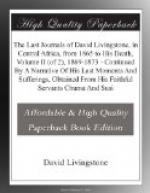When at last we got out of the forest and crossed the Liya on to the cleared lands near the villages of Monan-bundwa, we lay down to rest, and soon saw Muanampunda coming, walking up in a stately manner unarmed to meet us. He had heard the vain firing of my men into the bush, and came to ask what was the matter. I explained the mistake that Munangonga had made in supposing that I was Kolokolo, the deeds of whose men he knew, and then we went on to his village together.
In the evening he sent to say that if I would give him all my people who had guns, he would call his people together, burn off all the vegetation they could fire, and punish our enemies, bringing me ten goats instead of the three milch goats I had lost. I again explained that the attack was made by a mistake in thinking I was Mohamad Bogharib, and that I had no wish to kill men: to join in his old feud would only make matters worse. This he could perfectly understand.
I lost all my remaining calico, a telescope, umbrella, and five spears, by one of the slaves throwing down the load and taking up his own bundle of country cloth.
9th August, 1871.—Went on towards Mamohela, now deserted by the Arabs. Monanponda convoyed me a long way, and at one spot, with grass all trodden down, he said, “Here we killed a man of Moezia and ate his body.” The meat cut up had been seen by Dugumbe.
10th August, 1871.—In connection with this affair the party that came through from Mamalulu found that a great fight had taken place at Muanampunda’s, and they saw the meat cut up to be cooked with bananas. They did not like the strangers to look at their meat, but said, “Go on, and let our feast alone,” they did not want to be sneered at. The same Muanampunda or Monambonda told me frankly that they ate the man of Moezia: they seem to eat their foes to inspire courage, or in revenge. One point is very remarkable; it is not want that has led to the custom, for the country is full of food: nobody is starved of farinaceous food; they have maize, dura, pennisetum, cassava and sweet potatoes, and for fatty ingredients of diet, the palm-oil, ground-nuts, sessamum, and a tree whose fruit yields a fine sweet oil: the saccharine materials needed are found in the sugar-cane, bananas, and plantains.
Goats, sheep, fowls, dogs, pigs, abound in the villages, whilst the forest affords elephants, zebras, buffaloes, antelopes, and in the streams there are many varieties of fish. The nitrogenous ingredients are abundant, and they have dainties in palm-toddy, and tobacco or Bange: the soil is so fruitful that mere scraping off the weeds is as good as ploughing, so that the reason for cannibalism does not lie in starvation or in want of animal matter, as was said to be the case with the New Zealanders. The only feasible reason I can discover is a depraved appetite, giving an extraordinary craving for meat which we call “high.” They are said to bury a dead body for a couple of days in the soil in a forest, and in that time, owing to the climate, it soon becomes putrid enough for the strongest stomachs.




